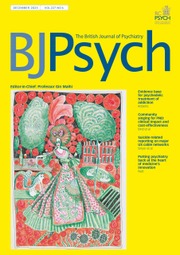Crossref Citations
This article has been cited by the following publications. This list is generated based on data provided by
Crossref.
Dykman, Roscoe A.
McPherson, Brian
Ackerman, Peggy T.
Newton, Joseph E. O.
Mooney, Donna M.
Wherry, Jeff
and
Chaffin, Mark
1997.
Internalizing and externalizing characteristics of sexually and/or physically abused children.
Integrative Physiological and Behavioral Science,
Vol. 32,
Issue. 1,
p.
62.
Granovsky, Yelena
Sprecher, Elliot
Hemli, Jeshayachu
and
Yarnitsky, David
1998.
P300 and stress in mild head injury patients.
Electroencephalography and Clinical Neurophysiology/Evoked Potentials Section,
Vol. 108,
Issue. 6,
p.
554.
Hansenne, M
2000.
Le potentiel évoqué cognitif P300 (II) : variabilité interindividuelle et application clinique en psychopathologie.
Neurophysiologie Clinique/Clinical Neurophysiology,
Vol. 30,
Issue. 4,
p.
211.
Stanford, Matthew S
Vasterling, Jennifer J
Mathias, Charles W
Constans, Joseph I
and
Houston, Rebecca J
2001.
Impact of threat relevance on P3 event-related potentials in combat-related post-traumatic stress disorder.
Psychiatry Research,
Vol. 102,
Issue. 2,
p.
125.
Galletly, Cherrie
Clark, C. Richard
McFarlane, Alexander C.
and
Weber, Darren L.
2001.
Working memory in posttraumatic stress disorder—an event‐related potential study.
Journal of Traumatic Stress,
Vol. 14,
Issue. 2,
p.
295.
Orr, Scott P
Metzger, Linda J
and
Pitman, Roger K
2002.
Psychophysiology of post-traumatic stress disorder.
Psychiatric Clinics of North America,
Vol. 25,
Issue. 2,
p.
271.
Clark, C.Richard
McFarlane, Alexander C
Morris, Philip
Weber, Darren L
Sonkkilla, Cynon
Shaw, Marnie
Marcina, Jackie
Tochon-Danguy, H.J
and
Egan, Gary F
2003.
Cerebral function in posttraumatic stress disorder during verbal working memory updating: a positron emission tomography study.
Biological Psychiatry,
Vol. 53,
Issue. 6,
p.
474.
Nandrino, Jean-Louis
Dodin, Vincent
Martin, Pascaline
and
Henniaux, Maurice
2004.
Emotional information processing in first and recurrent major depressive episodes.
Journal of Psychiatric Research,
Vol. 38,
Issue. 5,
p.
475.
Weber, Darren L.
Clark, C. Richard
McFarlane, Alexander C.
Moores, Kathryn A.
Morris, Philip
and
Egan, Gary F.
2005.
Abnormal frontal and parietal activity during working memory updating in post-traumatic stress disorder.
Psychiatry Research: Neuroimaging,
Vol. 140,
Issue. 1,
p.
27.
Karl, Anke
Malta, Loretta S.
and
Maercker, Andreas
2006.
Meta-analytic review of event-related potential studies in post-traumatic stress disorder.
Biological Psychology,
Vol. 71,
Issue. 2,
p.
123.
Shucard, Janet L.
McCabe, Danielle C.
and
Szymanski, Herman
2008.
An event-related potential study of attention deficits in posttraumatic stress disorder during auditory and visual Go/NoGo continuous performance tasks.
Biological Psychology,
Vol. 79,
Issue. 2,
p.
223.
de Jaeger, C.
and
Cherin, P.
2009.
Intérêt des potentiels évoqués cognitifs dans l’étude du vieillissement chez l’homme.
Médecine & Longévité,
Vol. 1,
Issue. 1,
p.
44.
Kimble, Matthew O.
Fleming, Kevin
Bandy, Carole
Kim, Julia
and
Zambetti, Andrea
2010.
Eye tracking and visual attention to threating stimuli in veterans of the Iraq war.
Journal of Anxiety Disorders,
Vol. 24,
Issue. 3,
p.
293.
Kimble, Matthew O.
Fleming, Kevin
Bandy, Carole
and
Zambetti, A.
2010.
Attention to novel and target stimuli in trauma survivors.
Psychiatry Research,
Vol. 178,
Issue. 3,
p.
501.
Tillman, Gail D.
Kimbrell, Timothy A.
Calley, Clifford S.
Kraut, Michael A.
Freeman, Thomas W.
and
Hart, John
2011.
Repetitive Transcranial Magnetic Stimulation and Threat Memory: Selective Reduction of Combat Threat Memory P300 Response After Right Frontal-Lobe Stimulation.
The Journal of Neuropsychiatry and Clinical Neurosciences,
Vol. 23,
Issue. 1,
p.
40.
Javanbakht, Arash
Liberzon, Israel
Amirsadri, Alireza
Gjini, Klevest
and
Boutros, Nash N
2011.
Event-related potential studies of post-traumatic stress disorder: a critical review and synthesis.
Biology of Mood & Anxiety Disorders,
Vol. 1,
Issue. 1,
MacNamara, Annmarie
Post, David
Kennedy, Amy E.
Rabinak, Christine A.
and
Phan, K. Luan
2013.
Electrocortical processing of social signals of threat in combat-related post-traumatic stress disorder.
Biological Psychology,
Vol. 94,
Issue. 2,
p.
441.
Johnson, J. D.
Allana, T. N.
Medlin, M. D.
Harris, E. W.
and
Karl, A.
2013.
Meta-Analytic Review of P3 Components in Posttraumatic Stress Disorder and Their Clinical Utility.
Clinical EEG and Neuroscience,
Vol. 44,
Issue. 2,
p.
112.
Shu, I-Wei
Onton, Julie A.
Prabhakar, Nitin
O'Connell, Ryan M.
Simmons, Alan N.
and
Matthews, Scott C.
2014.
Combat veterans with PTSD after mild TBI exhibit greater ERPs from posterior–medial cortical areas while appraising facial features.
Journal of Affective Disorders,
Vol. 155,
Issue. ,
p.
234.
Wu, Jianhui
Yuan, Yiran
Cao, Chengqi
Zhang, Kan
Wang, Li
and
Zhang, Liang
2015.
The relationship between response inhibition and posttraumatic stress symptom clusters in adolescent earthquake survivors: An event-related potential study.
Scientific Reports,
Vol. 5,
Issue. 1,



eLetters
No eLetters have been published for this article.